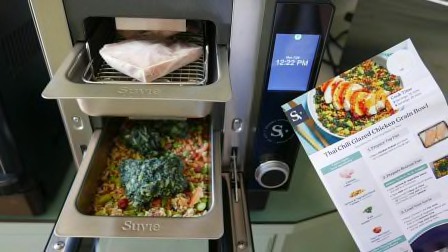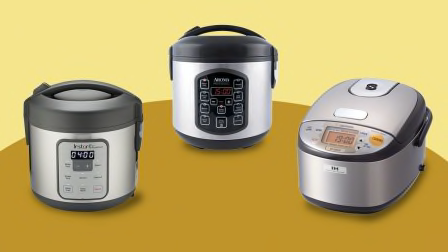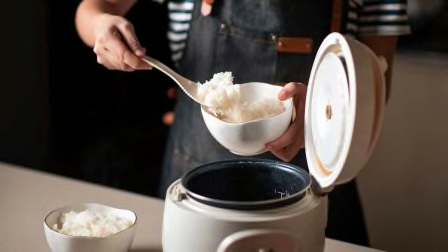How to Clean a Rice Cooker
It's trickier than you might think—and success is in the details
When you shop through retailer links on our site, we may earn affiliate commissions. 100% of the fees we collect are used to support our nonprofit mission. Learn more.

I’ve been cleaning my rice cooker all wrong.
Meaning I’ve really just been washing the bowl with every use but neglecting to clean other parts of it, including the removable inner lid, because, well, the steam should help keep it clean, right? Well, no.
Scrub and Rinse the Inner Pot
Rice cookers consist of a main body, which includes the heating plate and buttons, and a removable pot, which fits into the body and holds the rice you’d like to cook. After each use, unplug the appliance and let it cool before cleaning.
Start with the pot. Gently scrub away gummy residue with a nonabrasive sponge. The pot may be dishwasher-safe. Otherwise, rinse it and wipe it dry.
If rice remains stubbornly stuck to the surface, soak the rice cooker in warm water and dish soap before scrubbing again. Ginny Lui, who leads kitchen appliance testing at CR and uses a rice cooker at home, says she lets it soak for 5 minutes while she turns her attention to washing her other dishes.
To make cleaning the pot easier in the future, minimize the use of the “keep warm” function. Using that feature in our tests sometimes resulted in rice being almost baked onto the bottom and sides of the bowl, says Larry Ciufo, CR’s senior test project leader for rice cookers.
Worth noting: While nonstick rice cooker pots may often be easier to clean, they—like other nonstick cookware—could contain PTFE, a harmful PFAS chemical, which breaks down very slowly, if at all, and can be harmful to your health and the environment.
If you see peeling or scratching on the pot’s nonstick coating, get rid of the pot. You may be able to buy a new one on the manufacturer’s website (or elsewhere online) instead of paying for an entirely new rice cooker. Consider a rice cooker that has an aluminum or stainless steel pot.
Clean Detachable Parts (by Actually Detaching Them)
In addition to the bowl, there are often additional parts that need washing. These are detachable, which makes cleaning them easier. (If you’re not sure which parts of your rice cooker are detachable, consult the owner’s manual or find guidance online by searching with your rice cooker’s model name or number.)
For instance, many rice cookers, like my Zojirushi Induction model, have an inner lid that accumulates what amounts to rice paper, or the starchy residue that comes from the steam on its way out. I had been simply wiping it down. But what I should have been doing is this: Remove it from the outer lid and scrub away the dried film with a non-scratch sponge dampened with soapy water. After cleansing both sides, rinse and let dry.
If your rice cooker has a condensation collector, make sure to clean that, too, after each use. Dump out any water, and clean with a damp, soapy cloth. A chopstick often helps to get into the corners. Rinse and wipe dry.
Don't Forget the Heating Plate and Sensor
Even though your rice seems safely contained in the pot, you still need to clean the interior of the rice cooker itself, where the pot is ensconced and the heating plate is housed. A dirty heating plate and sensor could compromise your machine’s ability to cook the rice and may affect the flavor.
Again, after every use, unplug the machine and wait until it has cooled. Then use a dry sponge or towel to wipe away residual cooking water. Pick up any dried rice grains that may have fallen in. If you see discoloration, check your manual and follow the manufacturer’s guidance.
Wipe Down Interior and Exterior Surfaces
Most of us remember to wipe down the exterior of our rice cookers, where it can collect dust. But pay attention to hidden dirty spots, too.
Nooks around any physical buttons on the outside of a rice cooker can accumulate gunk. Errant grains and splatter can linger in the ridges. Use a toothpick to scrape that stuff out.
Rogers, a self-proclaimed food safety curmudgeon, scrubs the parts that aren’t dishwasher-safe with warm soapy water and, if needed, a scrub brush. Wipe down and let dry.
3 Easy-to-Clean Rice Cookers
These high-performing models are simpler than most to keep pristine. For more options, see our comprehensive rice-cooker ratings.


























